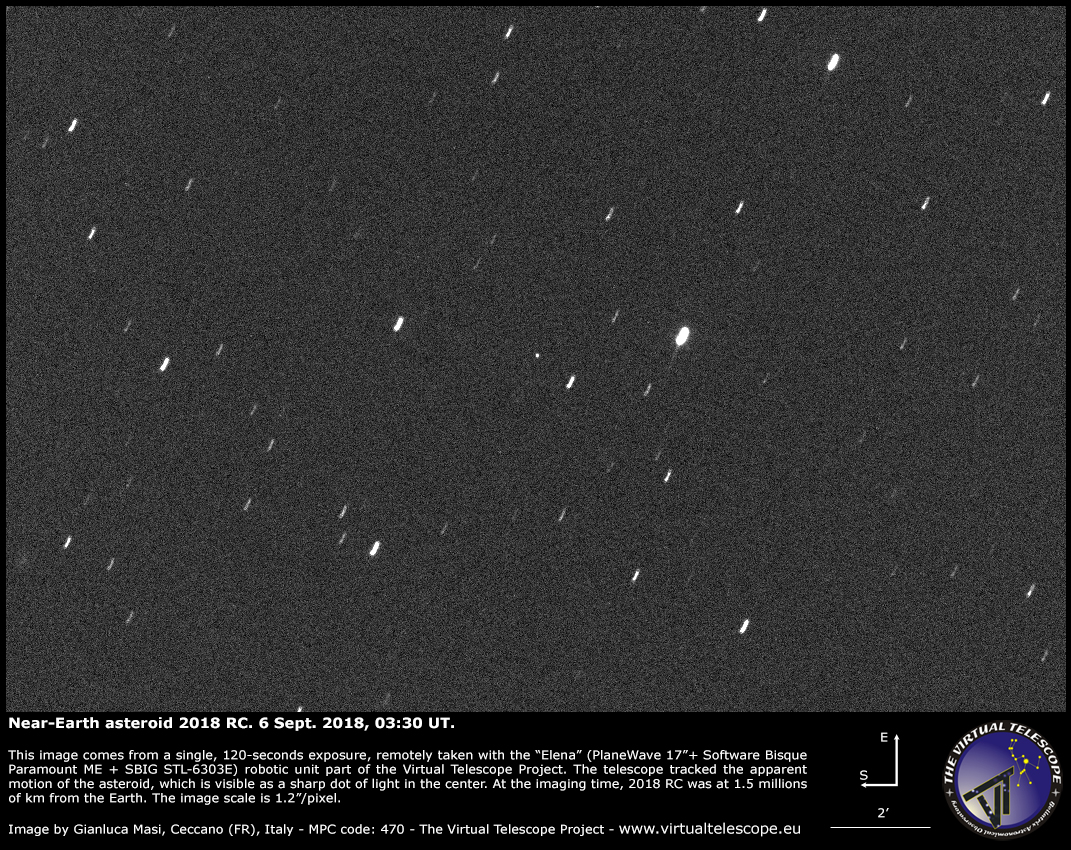Two Small Asteroids Are Buzzing Earth This Weekend. See One Live Tonight!
A newfound near-Earth asteroid will buzz the Earth at a range closer than the moon on Sunday (Sept. 9), and you can watch its approach in a live webcast tonight (Sept. 8). The flyby will come on the heels of a car-size asteroid that flies even closer to Earth tonight, according to NASA.
The Sunday asteroid, named 2018 RC, is about the size of a jumbo jet, according to NASA's Asteroid Watch team. It was discovered Sept. 3 by the Asteroid Terrestrial-impact Last Alert System (ATLAS) in Hawaii and will pass within 136,000 miles (220,000 kilometers) of the Earth when it makes its closest approach to Earth on Sunday. That's well inside the average distance between the Earth and the moon. The moon is on average about 238,000 miles (382,900 km) from the Earth. [Gallery: Potentially Dangerous Asteroids]
The Virtual Telescope Project, an online observatory founded by astrophysicist Gianluca Masi of the Bellatrix Astronomical Observatory in Ceccano, Italy, will host a live webcast this evening starting at 6 p.m. EDT (2200 GMT), and you can watch it live here on Space.com, courtesy of the Virtual Telescope Project, or directly at virtualtelescope.eu/webtv.
Asteroid 2018 RC is somewhere between 100 to 230 feet (32 to 71 meters) in diameter - a NASA estimate pegged the space rock's width at 130 feet ( 40 m) - and will appear as a 12th-magnitude speck of light that can be seen with small telescopes (larger than 4 inches, or 10 cm). During tonight's webcast, Masi will use a robotic telescope to easily keep an eye on the asteroid as it traverses a backdrop of stars.
Sunday's 2018 RC asteroid encounter will follow an even closer flyby of the newly discovered asteroid 2018 RW, which was only spotted by astronomers on Friday (Sept. 7), according to NASA. But this asteroid is much smaller, only 10 feet (3 m) across. It's about the size of a car, according to NASA's Asteroid Watch team.

Email Hanneke Weitering at hweitering@space.com or follow her @hannekescience. Follow us @Spacedotcom, Facebook and Google+. Original article on Space.com.
Get the Space.com Newsletter
Breaking space news, the latest updates on rocket launches, skywatching events and more!
Join our Space Forums to keep talking space on the latest missions, night sky and more! And if you have a news tip, correction or comment, let us know at: community@space.com.

Hanneke Weitering is a multimedia journalist in the Pacific Northwest reporting on the future of aviation at FutureFlight.aero and Aviation International News and was previously the Editor for Spaceflight and Astronomy news here at Space.com. As an editor with over 10 years of experience in science journalism she has previously written for Scholastic Classroom Magazines, MedPage Today and The Joint Institute for Computational Sciences at Oak Ridge National Laboratory. After studying physics at the University of Tennessee in her hometown of Knoxville, she earned her graduate degree in Science, Health and Environmental Reporting (SHERP) from New York University. Hanneke joined the Space.com team in 2016 as a staff writer and producer, covering topics including spaceflight and astronomy. She currently lives in Seattle, home of the Space Needle, with her cat and two snakes. In her spare time, Hanneke enjoys exploring the Rocky Mountains, basking in nature and looking for dark skies to gaze at the cosmos.









